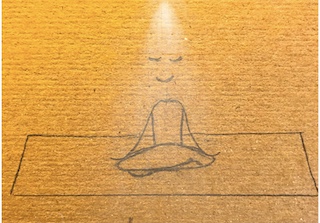Spirit
The Eight Limbs of Yoga

Yoga is more than bendy poses and stretchy pants
Yoga in the West, as most of us know it, is presented as the practice of physical poses (asanas) that strengthen our bodies and help us develop better balance and flexibility. All good stuff! But…in the media, including social media, yoga is also often packaged with images of white, thin, perfectly-toned, female practitioners in the latest and trendiest yoga fashion in exotic locales or in ultra-modern, minimalist studios. I would bet that for a lot of us, these images make us feel intrigued and simultaneously inadequate, unwelcome, or anxiously competitive.
I want to tell you that yoga is for everyone, and it’s more than just how far you can do the splits, how long you can hold a headstand, or whether you can touch your head with your toes.
Yoga is so much more. It provides for us an entire framework for building a healthier and more peaceful life beyond what we do on the yoga mat.
You can be skinny, fat, disabled, able-bodied, male, female, gender non-conforming, black, brown, or any other color to do it. Once you filter through all the toxic yoga content on Instagram that emphasizes looks and extreme contortion for its own sake, you’ll find many yoga practitioners of varying genders, racial and cultural backgrounds, sizes, and those with different disabilities who show us that yoga asanas can be modified for anyone. There are also yoga practitioners who specialize in teaching people who are processing trauma or working to overcome addiction. There is a style of yoga for you, whoever you are, wherever you are in your life, if you want to try it.
The original yoga was developed over 5000 years ago in India and contains eight parts, usually referred to as the limbs of yoga. The eight limbs are intended to be practiced in a sequence and create a path to physical, mental, and emotional peace and enlightenment. Six of the limbs are behavioral in their nature, and two of them consist of the physical practice of yoga: asanas (poses) and pranayama (breath work). The following terms are in Sanskrit, the original language of yoga.
Here is a summary of the Eight Limbs of Yoga:
Limb 1 Yama-The ethical ways to interact with others
Yama breaks down into these areas of behavior:
1) Ahimsa – non-violence; non-harming of the self and others in every sense: physical, mental, emotional, etc.
2) Satya – truthfulness with the self and others
3) Asteya – non-stealing; not taking more than is offered; respecting another’s time/energy/space
4) Brahmacharya – restraint in sexual or other ways that bring deep pleasure; moderation in areas of desire or other impulses
5) Aparigraha –non-coveting; non-grasping of unnecessary things, tangible and immaterial
Limb 2 Niyama-The way we manage ourselves and create positive habits
Niyama breaks down into these habits:
1) Saucha – purity, cleanliness, neatness; provides clarity in the mind for easier practice
2) Santosha – contentment; deep satisfaction for things as they are; non-craving for unnecessary things
3) Tapas – self-discipline; often associated with heat, purification, and building mental and physical strength
4) Svadhyaya – self-study; self-reflection; study of sacred or other meaningful texts for deepening the understanding of one’s practice
5) Ishvara Pranidhana: surrender to forces greater than oneself; for some this is God; releasing attachment to one’s ego for the greater good
Limb 3 Asana-The physical poses of the yogic practice
Limb 4 Pranayama-The breath work of a yogic practice; consists of breathing exercises that
- strengthen the respiratory system
- calm the nervous system
- enhance mood and energy
- cultivate mental discipline
Limb 5 Pratyahara-Withdrawal from the senses/external distractions; narrowing mental attention to inner realms
Limb 6 Dharana-The cultivation of concentration by focusing on a single object or mantra (devotional or aspirational phrase); common object of concentration is a candle flame
Limb 7 Dhyana-The uninterrupted flow of concentration; quiet mind; achievement of singular focus
Limb 8 Samadhi-Transcendence; pure peace; sense of oneness with all/the universe; loss of ego; enlightenment.
Final Thoughts and Take-Aways
Enlightenment is not a permanent state, as far as I understand it in yogic terms. It comes and goes in fleeting moments of clarity and deep understanding. I believe moments of Samadhi become more accessible and longer-lasting with regular practice of the Eight Limbs of Yoga, but even if we never experience complete bliss and oneness with the universe, even if we never become expert meditators or master every yoga pose, all the other benefits of yoga remain deeply worthwhile endeavors. Setting our intentions on practicing the Eight Limbs of Yoga provides tons of physical, mental, emotional, and interpersonal benefits.
Want to begin a yoga practice but don’t know where to start? There are great yoga teachers on YouTube who share tons of free content to help you get started at home. Click around and try some different channels until you find some teachers you like. Try search terms like “gentle yoga” or “beginner yoga” if you’re new trying the asanas. I make beginner-appropriate yoga videos you can check out here.
Want to get out of the house? You could start attending yoga classes at a studio or find a yoga teacher to work with in one-on-one classes. Of course, there’s also a ton of information on the internet about every aspect of yoga practice, and your journey can be as gentle or as intense as you want to make it! Enjoy your path to peace!
by KaDee Bramlett
published 01/01/2021
This is an ad-free space. If you'd like to contribute to help me continue creating this content, I accept contributions on Venmo @KaDee-Bramlett. Thank you!